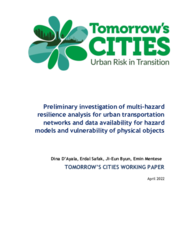“Horizontal settlements to reduce earthquake disaster risk and more green spaces that can be used as post-earthquake assembly areas”.
Zeynep, 22, student, resident of Büyükçekmece District.
Summary
Istanbul is Türkiye's largest city. Its proximity to the North Anatolian Fault Zone makes the city highly prone to earthquakes, but other hazards such as landslides and floods are also common.
The combined impact of hazards is not evenly distributed. Illegal informal settlements, for example, accumulate risk through poor structural resilience and increasing social vulnerabilities. These have undergone different phases of transformation in response to pressures from migration and urban expansion. New urban transformation projects are now underway amid different reactions from different parts of society.

Istanbul Challenges
Earthquakes
Istanbul lies on the North Anatolian Fault line, which has a history of producing devastating earthquakes.
- Between 1939 and 1999, Istanbul experienced 17 earthquakes with a magnitude of 5 or higher.*
- The most destructive earthquake in recent history was the 1999 Marmara earthquake, which had a magnitude of 7.4 resulting in over 17,000 deaths and extensive damage to buildings and infrastructure.
*Istanbul Earthquake Rapid Response and Early Warning System

Damaged buildings in the 1999 Marmara earthquake. Source: https://www.dailysabah.com/

Damaged buildings in the 1999 Marmara earthquake. Source: https://www.t-vine.com/
Floods
The city's rapid urbanization, combined with inadequate infrastructure and poor land management, increases the risk of flooding. For example, in 2009, heavy rainfall led to widespread flooding in Istanbul, resulting in the loss of 31 people and the cost of damage has been estimated as being in excess of $70 million.

2009 Flash floods in Turkey.
Migration
Rural to urban migration is a significant phenomenon in Turkey, driven by a combination of economic, social, and demographic factors. Many rural areas in Turkey face challenges such as limited job opportunities, low agricultural productivity, and lack of basic infrastructure. As a result, people have been migrating to urban areas in search of better economic prospects, including formal employment, higher wages, access to education, healthcare. Approximately only 18% of the population in Istanbul is registered to the city.
Aside from domestic immigration; Turkey currently hosts one of the largest migrant populations in the world, with 3.9 million* registered migrants and refugees residing in the country. The majority of these migrants are Syrian, fleeing ongoing conflicts in that country. According the reports, there are more than 500.000 Syrian refugees living in Istanbul.
*https://www.unhcr.org/tr/en/refugees-and-asylum-seekers-in-turkey
*https://multeciler.org.tr/turkiyedeki-suriyeli-sayisi/

Kilis Refugee Camp in southeasthern Turkey.
Building Codes
Issues with building codes in Turkey, including informal settlements, accelerated construction without proper compliance with building codes, and inadequate preparation for hazards such as earthquakes, have been documented by various sources including reports from UN-Habitat, the World Bank, Earthquake Engineering Research Institute, and media coverage from Turkish outlets.
The UN-Habitat has conducted research on informal settlements and housing conditions in Turkey, highlighting that the rapid urbanization and population growth in Turkey have led to the proliferation of housing often built without complying with formal building codes.
Similarly the World Bank has published reports that highlight the lack of proper controlling mechanisms to ensure compliance with building codes, resulting in buildings being constructed hastily without adhering to the necessary safety regulations.
Key stakeholders
Instabul key stakeholders represent three groups from the institutional and private sectors and the community.
Institutional Stakeholders
- Büyükçekmece District Municipality (BM)
- İstanbul Metropolitan Municipality (IMM)
- Disaster and Emergency Management Authority (AFAD)
- Presidency Strategic Planning and Budget Directorate
- Ministry of Environment, Urbanisation and Climate Change
- Ministry of Family and Social Services (MFSS)
- Istanbul City Council (ICC)
Private Stakeholders
- Construction Sector Representatives in the case area
- Real Estate Representatives
Community Stakeholders
- Local Associations of women, youth, disabled, elderly, contemporary life
- Hometown Associations
- Neighbourhood Association
- Women
- Youth
- Disabled
- Elderly
- Poor who depend on social assistance for living
- Roma people
- Refugee group (Syrians)
- Chambers/ Association of Architects/ Engineers/ Planners / Environmentalists

Istanbul’s approach using the TCDSE.
In Istanbul, the local team of Tomorrow's Cities has identified a case study area in the Büyükçekmece District.
Situated in the western part of Istanbul, Büyükçekmece is home to over 300,000 residents. Despite being susceptible to various hazards such as landslides, liquefaction, and tsunamis, the team specifically focused their efforts on assessing earthquake risk. This decision was driven by the forecast of a significant earthquake due to the proximity of the active North Anatolian Fault.

Büyükçekmece District Istanbul

An analysis of social vulnerability in a multi-hazard urban context for improving disaster risk reduction policies: The case of Sancaktepe, ˙Istanbul
Despite concerted calls over the past 20 years to ensure that urban development is undertaken in nmanner that reduces disaster risk, urban planning often remains myopically focused on the built en

Preliminary investigation of multi-hazard resilience analysis for urban transportation networks and data availability for hazard models and vulnerability of physical objects
HUB-Istanbul work package (WP) 2.6 aims to develop tools to analyse the multi-hazard resilience of urban transportation network in complex and evolving metropolitan environment, a

Identification of Structural Properties of the Incirli Pedestrian Bridge and Structural Response Analysis
Incirli Pedestrian bridge links the Bakirköy and Bahçelievler districts of Istanbul by crossing over the D100 highway and being exposed to heavy pedestrian traffic in peak-hours, since it is the on

Landslide Risk Report of Istanbul
Istanbul, landslides are the first largest disaster in terms of the number of incidents and the second-largest natural disaster after earthquakes in terms of affected houses.

Earthquake Performance of Cevizlibağ Metrobus Overpass
Cevizlibağ Metrobus Overpass has a very important place in Istanbul transportation due to its high pedestrian density and its location on the main ro

Tomorrow’s Cities: Multi-hazard interactions to inform disaster risk reduction in Istanbul
Istanbul is a major global urban centre.





